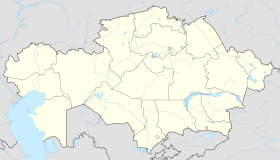Fārāb
|
Otrar Отырар Отрар |
|
|---|---|
| Location in Kazakhstan | |
| Coordinates: 42°51′09″N 68°18′10″E / 42.85250°N 68.30278°ECoordinates: 42°51′09″N 68°18′10″E / 42.85250°N 68.30278°E | |
| Country | Kazakhstan |
| Province | South Kazakhstan Province |
| Founded | before 8th century |
| Elevation | 506 m (1,660 ft) |
| Time zone | ALMT (UTC+6) |
| Postal code | 160000 |
Otrar or Utrar (Kazakh: Отырар Otırar; also called Farab) is a Central Asian ghost town that was a city located along the Silk Road in Kazakhstan. Otrar was an important town in the history of Central Asia, situated on the borders of settled and agricultural civilizations. It was the center of a great oasis and political district, commanding a key point connecting Kazakhstan with China, Europe, Near and Middle East, Siberia and Ural.
The first known state in the region was known to Chinese scholars as Kangju, which was centered on the Syr Darya (also known as the Kang River). Kangju existed from the 1st century BC until the 5th century AD. Its capital was reportedly at or near Bityan. After being subject to several different waves of invaders Kangju, collapsed into several independent states situated mainly in the Syr Darya valley and its tributuaries of Keles and Atysi. Its people appear to have Turkified, becoming known as the Kangars.
There are records that portray the determination of earlier names of Farab. It is thought that a group of coins collected in Otrar and some towns of the oasis date back to the time of these records. There is a generic symbol of the Turgeshi in the form of a bow on the face-side of such coins and the image of a lion on the reverse side. On a second type of coin, there is an "X" sign on the reverse side; these may originate from the mint of a local ruler. There is a suggestion that the coins of the second type were minted by rulers of the Turkic state of Kangu Tarban, the population of which were the Kangars. According to the coins, in the 6th to 8th centuries, Kangu Tarban was ruled by a local dynasty of the Kangars, and their capital became a Tarban town named Turarband that was later to be called Otrar. Since the times of the golden hordes, the ruins of Otrar have been attractive because of rumours about the treasures of the ancient rulers, and about buried piles of gold coins and jewelry. The source of such legends was perhaps confirmed by the archaeological finds of various coins and jewelry.
...
Wikipedia

